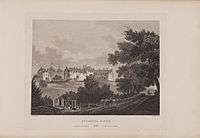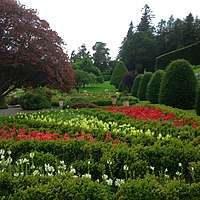Drummond Castle
Drummond Castle is located in Perthshire, Scotland. The castle is known for its gardens, described by Historic Environment Scotland as "the best example of formal terraced gardens in Scotland."[1] It is situated in Muthill parish, 4 kilometres (2.5 mi) south of Crieff. The castle comprises a tower house built in the late 15th century, and a 17th-century mansion, both of which were rebuilt in Victorian times. The gardens date to the 1630s, although they too were restructured in the 19th century. The formal gardens are protected as a category A listed building,[2] and are included on the Inventory of Gardens and Designed Landscapes in Scotland.[1] The tower house and mansion are both category B listed.[3][4]


History
The lands of Drummond were the property of the Drummond family from the 14th century, and the original tower house was built over several years by John Drummond, 1st Lord Drummond of Cargill, from about 1490. In 1605 the 4th Lord Drummond was created Earl of Perth, and added to the castle. The 2nd Earl of Perth laid out the first terraced garden around the castle in the 1630s.[1]
The castle was sacked by the army of Oliver Cromwell in 1653, during the Wars of the Three Kingdoms.[1] The 4th Earl of Perth was Lord Chancellor of Scotland under King James VII. He began the mansion house in 1689, before being imprisoned following the deposition of King James by William of Orange. He later fled to the exiled Jacobite court in France. The Drummonds continued to support the Jacobite cause in the Jacobite uprisings of 1715 and 1745. The family retained control of the estate until 1750 when the Drummond properties were declared forfeit and seized by the state. The estate was managed by the Commissioners for Forfeited Estates until 1784, when it was sold to Captain James Drummond (later created 1st Baron Perth). He began a number of improvements that were continued by his daughter Sarah and her husband, The 22nd Baron Willoughby de Eresby (1782–1865). These included the formal gardens and terraces in the 1830s. Queen Victoria visited the gardens in 1842.[1]
Drummond Castle passed to The 24th Baroness Willoughby de Eresby (1809–1888), and then to her son, The 1st Earl of Ancaster (1830–1910). The upper stories of the tower house were rebuilt and heightened in pseudo-medieval style in 1842–53. The mansion was renovated in 1878, to designs by George Turnbull Ewing. The 3rd Earl of Ancaster and his wife, Nancy Astor (1909–1975; she was the daughter of The 2nd Viscount Astor and The Viscountess Astor), replanted the gardens in the 1950s.[1] The castle is now the seat of The Rt Hon. The 28th Baroness Willoughby de Eresby, the daughter and heir of The 3rd Lord Ancaster.
Description
The castle is set on part of a prominent spine of rock known as the Gask Ridge, a geographical feature that stretches several kilometres across Perthshire, but is particularly prominent and steep-sided at the site of the castle. The tower house, or keep, is no longer used as a dwelling. It is adjoined by a later, but better preserved, gatehouse (built 1629–30). Stretching between the tower house and the edge of the ridge, it was originally intended to control access to the courtyard behind, which has a fine view over the formal gardens. To the south of the castle on its rocky outcrop are the formal gardens.
The buildings and gardens of Drummond Castle featured as backdrops in the 1995 film Rob Roy.
Gallery
 Etching of Drummond Castle from James Fittler's Scotia Depicta, published 1804
Etching of Drummond Castle from James Fittler's Scotia Depicta, published 1804 Drummond Castle from the baroque garden
Drummond Castle from the baroque garden Drummond Castle baroque garden
Drummond Castle baroque garden Drummond Castle ornamental architecture
Drummond Castle ornamental architecture Drummond Castle baroque garden's statue
Drummond Castle baroque garden's statue Drummond Castle's baroque garden
Drummond Castle's baroque garden
References
- Historic Environment Scotland. "DRUMMOND CASTLE (GDL00144)". Retrieved 24 February 2019.
- Historic Environment Scotland. "DRUMMOND CASTLE, FORMAL GARDEN (Category A) (LB19883)". Retrieved 24 February 2019.
- Historic Environment Scotland. "DRUMMOND CASTLE, KEEP (Category B) (LB18078)". Retrieved 24 February 2019.
- Historic Environment Scotland. "DRUMMOND CASTLE, MANSION (Category B) (LB18042)". Retrieved 24 February 2019.
External links
![]()
- Drummond Castle Gardens website
- Gazetteer for Scotland
- Flickr images tagged Drummond Castle
- Engraving of Drummond castle by James Fittler in the digitised copy of Scotia Depicta, or the antiquities, castles, public buildings, noblemen and gentlemen's seats, cities, towns and picturesque scenery of Scotland, 1804 at National Library of Scotland